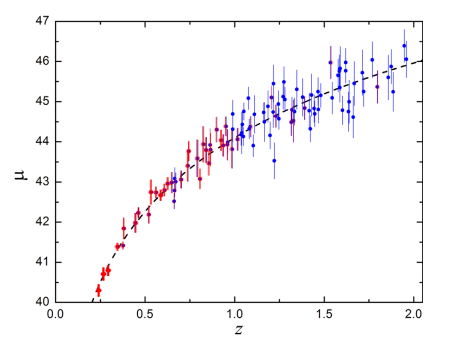The presence of cosmic opacity can lead to a significant deviation from photon number conservation,thus making the observed Type Ia supernovae (SNe Ia) dimmer than what expected and affecting the reliablereconstruction of the cosmic expansion history. It is therefore crucial to quantitativelystudy the effect of cosmic opacity on SN standard candles. Since the waveform signals of gravitational waves (GWs) from inspirallingand merging compact binaries encode distance information, GWs can be deemed as standard sirens for probing cosmology if their electromagnetic counterparts with known redshifts can be detected. Unlike the distance calibrations of SNe Ia that are affected by cosmic opacity, distance measurements from GW observations have the advantage of being insensitive to the non-conservation of photon number. Therefore, GW standard sirens provide a novel way to determine the opacity-independent distances of SNe Ia at the same redshifts. 
By with WEI Junjie Fig. Example catalog of 100 simulated GW events (blue dots) with redshifts, z; distance moduli, μ; and the errors in the distance moduli, σμ. The dashed line is the fiducial flat ΛCDM model. Red circles represent 213 Pantheon SNe Ia whose distance moduli are determined by the nearest GW data; the other 835 SNe Ia that have redshift differences Δz 0.005 with respect to their corresponding nearest GW data are discarded.In this work, we first propose that unbiased cosmic opacity tests can be performed by combining SN Ia and GW data in similar redshift ranges. Through Monte Carlo simulations,we show that one can constrain the cosmic opacity parameter kappa with an accuracy of sigma_kappa=0.046 by comparing the distances from 1048 current Pantheon SNe Ia and 100 simulated GW events(see Fig. 1). If 800 GW eventsare observed, the uncertainty of kappa can be further reduced to ~0.026.We also demonstrate that with 2000 simulated SNe Ia and 1000 simulated GW events,one can expect the transparent universe to be estimated at the precision of kappa=0.0000+/-0.0044. By comparing our results with previous opacity constraints involving distances from different observations, we prove that our method using GW standard sirens and SN Ia standard candles will be competitive. Most importantly, our method offers a new model-independent way to constrain cosmic opacity. This work has been published in The Astrophysical Journal. Please see ApJ, 876, 66 (2019) for more details (https://doi.org/10.3847/1538-4357/ab1587 ). |
